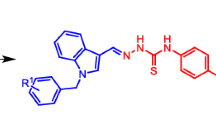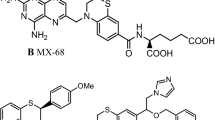Abstract
Increased bacterial resistance to antibiotics is a major threat to human health, and it is particularly important to develop novel antibiotic drugs. Here, we designed a series of Schiff base thiosemicarbazone derivatives containing an adamantane moiety, and carried out the structural characterization of the compounds and in vitro antibacterial activity tests. Compound 7e was as effective as the commonly used antibiotic ampicillin against the Gram-negative bacterium Escherichia coli, and compound 7g had a good inhibitory effect against Gram-positive Bacillus subtilis. These findings provide data for the development of better thiosemicarbazone antibacterial agents.

Similar content being viewed by others
References
Ventola CL. The antibiotic resistance crisis: Part 1: Causes and threats. Pharm Ther. 2015;40:277–83
Brooks BD. Therapeutic strategies to combat antibiotic resistance. Adv Drug Deliv Rev. 2014;78:14–27. https://doi.org/10.1016/j.addr.2014.10.027
Livermore DM. The need for new antibiotics. Clin Microbiol Infect. 2004;10:1–9. https://doi.org/10.1111/j.1465-0691.2004.1004.x
Puertoa SA, Fernandeza GJ, Castillo LDJ, Pino SJM, Angulo PG. In vitro activity of beta-lactam and non-beta-lactam antibiotics in extended-spectrum beta-lactamase-producing clinical isolates of Escherichia coli. Diagn Microbiol Infect Dis. 2006;54:135–9. https://doi.org/10.1016/j.diagmicrobio.2005.08.018
Krishnanjaneyulu IS, Saravanan G, Vamsi J, Supriya P, Bhavana JU, Sunil Kumar MV. Synthesis, characterization and antimicrobial activity of some novel benzimidazole derivatives. J Adv Pharm Technol Res. 2014;5:21–27. https://doi.org/10.4103/2231-4040.126983
Moellering RC Jr. Discovering new antimicrobial agents. Int J Antimicrob Agents. 2011;37:2–9. https://doi.org/10.1016/j.ijantimicag.2010.08.018. 2011
De Araújo Neto LN, De Lima M, do CA, De Oliveira JF, et al. Thiophene-thiosemicarbazone derivative (L10) exerts antifungal activity mediated by oxidative stress and apoptosis in C. albicans. Chem Biol Interact. 2020;320:109028 https://doi.org/10.1016/j.cbi.2020.109028
Khan SA, Kumar P, Joshi R, Iqbal PF, Saleem K. Synthesis and in vitro antibacterial activity of new steroidal thiosemicarbazone derivatives. Eur J Med Chem. 2008;43:2029–34. https://doi.org/10.1016/j.ejmech.2007.12.004
Matsa R, Makam P, Kaushik M, Hoti SL, Kannan T. Thiosemicarbazone derivatives: design, synthesis and in vitro antimalarial activity studies. Eur J Pharm Sci. 2019;137:104986 https://doi.org/10.1016/j.ejps.2019.104986
Zhang X, Qi F, Wang S, Song J, Huang J. Synthesis, structure, in silico ADME evaluation and in vitro antioxidant of (E)-N-(4-ethylphenyl)-2-(isomeric methylbenzylidene) thiosemicarbazone derivatives. J Mol Struct. 2020;1199:126972 https://doi.org/10.1016/j.molstruc.2019.126972
Trotsko N, Golus J, Kazimierczak P, Paneth A, Przekora A, Ginalska G, et al. Design, synthesis and antimycobacterial activity of thiazolidine-2,4-dione-based thiosemicarbazone derivatives. Bioorg Chem. 2020;97:103676 https://doi.org/10.1016/j.bioorg.2020.103676
He Z, Qiao H, Yang F, Zhou W, Gong Y, Zhang X, et al. Novel thiosemicarbazone derivatives containing indole fragment as potent and selective anticancer agent. Eur J Med Chem. 2019;184:111764 https://doi.org/10.1016/j.ejmech.2019.111764
Pham VH, Phan TPD, Phan DC, Vu BD. Synthesis and bioactivity of thiosemicarbazones containing adamantane skeletons. Molecules. 2020;25:324 https://doi.org/10.3390/molecules25020324
Siddiqui EJ, Azad I, Khan AR, Khan T. Thiosemicarbazone complexes as versatile medicinal chemistry agents: a review. J Drug Deliv Ther. 2019;9:689–703. https://doi.org/10.22270/jddt.v9i3.2888
Pervez H, Iqbal MS, Tahir MY, Choudhary MI, Khan KM. Synthesis of some N4-substituted isatin-3-thiosemicarbazones. Nat Prod Res. 2007;21:1178–86. https://doi.org/10.1080/14786410601129770
Basarić N, Sohora M, Cindro N, Mlinarić-Majerski K, De Clercq E, Balzarini J. Antiproliferative and antiviral activity of three libraries of adamantane derivatives. Arch Pharm. 2014;347:334–40. https://doi.org/10.1002/ardp.201300345. 2014
Fesatidou M, Zagaliotis P, Camoutsis C, et al. 5-Adamantan thiadiazole-based thiazolidinones as antimicrobial agents. Design, synthesis, molecular docking and evaluation. Bioorg Med Chem. 2018;26:4664–76. https://doi.org/10.1016/j.bmc.2018.08.004
Anusha S, Mohan CD, Ananda H, et al. Adamantyl-tethered-biphenylic compounds induce apoptosis in cancer cells by targeting Bcl homologs. Bioorg Med Chem Lett. 2016;26:1056–60. https://doi.org/10.1016/j.bmcl.2015.12.026
Göktaş F, Vanderlinden E, Naesens L, Cesur N, Cesur Z. Microwave assisted synthesis and anti-influenza virus activity of 1-adamantyl substituted N-(1-thia-4-azaspiro[4.5]decan-4-yl)carboxamide derivatives. Bioorg Med Chem. 2012;20:7155–9. https://doi.org/10.1016/j.bmc.2012.09.064
Fytas C, Zoidis G, Tsotinis A, Fytas G, Khan MA, Akhtar S, et al. Novel 1-(2-aryl-2-adamantyl)piperazine derivatives with antiproliferative activity. Eur J Med Chem. 2015;93:281–90. https://doi.org/10.1016/j.ejmech.2015.02.021
Aguiar DF, Dutra LLA, Dantas WM, et al. Synthesis, antitumor and cytotoxic activity of new adamantyl O-acylamidoximes and 3-aryl-5-adamantane-1, 2, 4-oxadiazole derivatives. Chem Sel. 2019;4:9112–8. https://doi.org/10.1002/slct.201901285
Tsuzuki N, Hama T, Kawada M, Hasui A, Konishi R, Shiwa S, et al. Adamantane as a brain-directed drug carrier for poorly absorbed drug. 2. AZT derivatives conjugated with the 1-adamantane moiety. J Pharm Sci. 1994;83:481–4. https://doi.org/10.1002/jps.2600830407
Gerzon K, Krumkalns EV, Brindle RL, Marshall FJ, Root MA. The adamantyl group in medicinal agents. I. Hypoglycemic N-arylsulfonyl-N’-adamantylureas. J Med Chem. 1963;6:760–3. https://doi.org/10.1021/jm00342a029
Rapala RT, Kraay RJ, Gerzon K. The adamantyl group in medicinal agents. II. Anabolic steroid 17-beta-adamantoates. J Med Chem. 1965;8:580–3. https://doi.org/10.1021/jm00329a007
Gerzon K, Kau D. The adamantyl group in medicinal agents. 3. Nucleoside 5’-adamantoates. The adamantoyl function as a protecting group. J Med Chem. 1967;10:189–99. https://doi.org/10.1021/jm00314a014
Martin YC, Kofron JL, Traphagen LM. Do structurally similar molecules have similar biological activity? J Med Chem. 2002;45:4350–8. https://doi.org/10.1021/jm020155c
Bender A, Jenkins JL, Scheiber J, Sukuru SCK, Glick M, Davies J. How similar are similarity searching methods? A principal component analysis of molecular descriptor space. J Chem Inf Model. 2009;49:108–19. https://doi.org/10.1021/ci800249s
Davis WW, Stout TR. Disc plate method of microbiological antibiotic assay. II. Novel procedure offering improved accuracy. Appl Microbiol. 1971;22:666–70
Valentine SC, Contreras D, Tan S, Real LJ, Chu S, Xu HH. Phenotypic and molecular characterization of Acinetobacter baumannii clinical isolates from nosocomial outbreaks in Los Angeles County, California. J Clin Microbiol. 2008;46:2499–507. https://doi.org/10.1128/JCM.00367-08
CLSI. Methods for dilution antimicrobial susceptibility tests for bacteria that grow aerobically; Approved Standard-Ninth Edition. M07-A9. Wayne, PA: Clinical and Laboratory Standards Institute; 2012
Acknowledgements
We thank Liwen Bianji, Edanz Group China (www.liwenbianji.cn/ac), for editing the English text of a draft of this manuscript.
Funding
This work was financially supported by the National Natural Science Foundation of China (21502008) and Natural Science Foundation of Jilin Province (00005005031).
Author information
Authors and Affiliations
Contributions
JZ and YX performed all experiments, purified all compounds, analyzed the data and summarized the results. JZ tested all compounds for their antibacterial activity. DL and GT helped in compiling the data of the manuscript. YX and RH conceived and designed this research and wrote the manuscript. All authors have contributed to the final version and approved the final manuscript.
Corresponding authors
Ethics declarations
Conflict of interest
The authors declare no competing interests.
Additional information
Publisher’s note Springer Nature remains neutral with regard to jurisdictional claims in published maps and institutional affiliations.
Rights and permissions
About this article
Cite this article
Zhu, J., Teng, G., Li, D. et al. Synthesis and antibacterial activity of novel Schiff bases of thiosemicarbazone derivatives with adamantane moiety. Med Chem Res 30, 1534–1540 (2021). https://doi.org/10.1007/s00044-021-02759-w
Received:
Accepted:
Published:
Issue Date:
DOI: https://doi.org/10.1007/s00044-021-02759-w




